Performing An Assisted Bridge Exercise For Patients With SMA (Part 1)

With a patient like Michael, who has SMA, it can be a challenge to continue growing their treatment plan by presenting new exercises that help them reach their goals. Often times we resort to starting a new exercise and modifying it depending on Michael’s performance.
Although I know it is not realistic for Michael to be able to independently perform bed mobility on his own, it is realistic to work towards him being able to assist in bed mobility and make some minor adjustments on his own to make himself more comfortable when in bed, or seated in his wheelchair. When working with a patient that has different factors to weigh in, sometimes you have an idea, but can’t figure out how to make it happen. This is when it’s nice to have a team of therapists around you to help brainstorm and modify exercises.
We decided assisted bridging would be a good way to gauge how and if Michael can fire his glutes, specifically the gluteus maximus. Gluteus maximus is primarily important in hip extension, which is the motion that is being performed with a bridge. With strength and ability to fire his glutes, we could potentially be able to weight shift from side to side in his wheelchair as well as help reposition himself in bed.
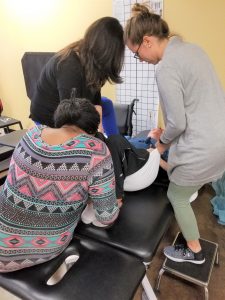

We placed a large sheet under Michael by rolling side to side and placing the sheet under his hips. Using three people, one on either side of Michael holding the sheet, and one at his feet to maintain contact with the therapy table, we then told Michael that he was going to try to push through his feet and squeeze his glutes to try and push up towards the head of the table, while the two therapists holding the sheet pull straight up towards the ceiling to assist him in his bridging.
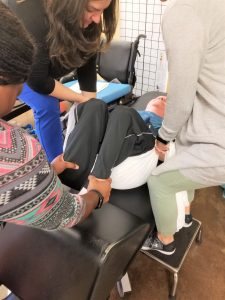
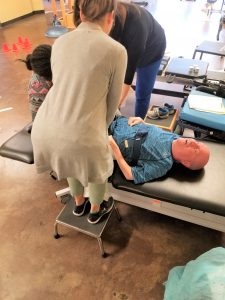
Michael has a fused lumbar spine, so we knew we wouldn’t be able to get much motion with the bridge, but wanted to try and get him firing his muscles on his own. We first tried with his feet as flat as we could get them on the therapy table and well as his head flat on the table. Since Michael has decreased dorsiflexion (lacking approximately 30-40 degrees bilaterally), and has decreased hip extension secondary to decreased hip flexors, as well as a fused lumbar spine, he had a hard time keeping his feet on the table to push, even with assistance to keep his feet down. We modified this by placing a wedge under his feet to increase his hip flexion and give him more range for hip extension before his feet come off of the table to contract his glutes on his own.
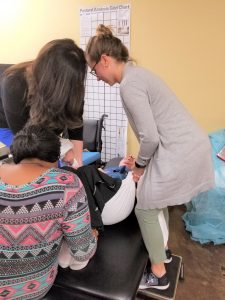
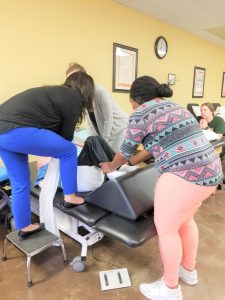
Michael had more success with the modified version and was more comfortable that way. He was able to get a better and more controlled contraction of his glutes and push up towards the head of the bed. Although he only has minor contraction and can only minimally push up towards the head of the bed, any contraction is something we can work on advancing. We went through this exercise approximately three sets of eight repetitions. Michael was able to get a pretty good contraction over the first approximately three times and then needed more assistance throughout the last five times secondary to fatigue. We will continue over the next few months advancing and modifying this exercise as we see fit to Michael.
======================== Patient Perspective ========================

Every once in a while, my physical therapists, Emily and Laura, will develop new exercises for me. Unbeknownst to me, they had been talking for quite some time about doing an exercise called an “assisted bridge”, and I learned of this exercise one day after performing my balance and range of motion exercises a few weeks ago. They wanted to see whether or not my glutes and quad muscles would activate. While this was all new to me, I trust Emily and Laura, so when they asked if I wanted to try performing this exercise, I agreed. While Emily and I talked about this exercise, Laura went and got a black resistance band, a gait belt and a bed sheet. You can imagine what was running through my mind when I saw Laura walking toward me with these items in her hand.
They both looked at me and smiled, which immediately sent red flags up in my head. I guess you could say that I felt like a piece of chicken about to be thrown into the frying pan. What were they planning to do to me, and was this going to be something that I would regret initially agreeing to? When they finally explained the objective of the assisted bridge exercise, it made better sense, which eliminated most of my fears. (You noticed that I said most of my fears, right?) The goal was to elevate my hips, while making sure that my feet were flat on the therapy table. With my hips elevated, I was then supposed to squeeze my glutes and quad muscles, along with tightening my abdominal muscles, and while doing this, they asked me to try to push my body up toward the top of the physical therapy table. While this was a lot for me to absorb, my thinking was, what do I had to lose?
The first couple of times that Emily and Laura elevated my hips, they told me to just relax and get used to the feeling of my hips being elevated, because this had never happened to me in the past. After doing this 4 or 5 times, they told me that after they elevated my hips, they wanted me to tighten my glutes, quads and abdominal muscles, and to try to push my body forward. With their physical therapy assistant holding my feet flat on the therapy table, Emily and Laura elevated my hips and I tightened every muscle in my body. The first couple of times that we did this, I never felt my body move. I think they could both tell that I was still somewhat confused as to exactly what I was supposed to be doing. Then, after a few tries, it actually happened. After elevating my hips, I squeezed my glutes, quads and abdominal muscles, and pushed with as much power as I could, and to my surprise, I felt my upper body move forward. While I only moved about 1/8 of an inch, both Emily and Laura looked at each other with a surprised look on their face. I questioned as to whether or not it was them moving my body forward, or was it actually me doing this? Laura looked at me and said that she and Emily were elevating my hips straight up, and they were in no way pushing my body forward. We did this about 10 more times, and I felt my body move each time. To say that I was emotional would be an understatement, and I think both Emily and Laura were as surprised as I was.
Over the next few months, Emily’s articles will track my progress, and we will report the positives and negatives each month, along with reporting any changes that we make to this assisted bridge exercise. Please keep your fingers crossed.



